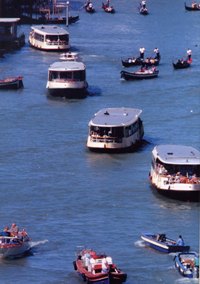The dynamics of waves aren’t so hard to understand — anybody who’s ever gone to the beach remembers the thump of the wave that has just arrived. (Am I the only person who’s ever noticed how much that sound resembles the slamming of the car doors as your family arrives for a visit?).
We don’t really notice what the thump does to the sand because an infinite series of them has already created the sand. It’s not a bad idea, though, to recall that the sand was once a hefty piece of mountain.
What isn’t so obvious, and maybe is even less obviously disturbing, is the hissing sound the wave makes as it departs. It is caused by a force called “risucchio,” (ree-SOOK-yo) which literally means “re-sucking,” though I suppose “undertow” is close enough for Anglophones. And it’s the force that tears asunder what was once clearly put together by God, man, or whatever’s in between.
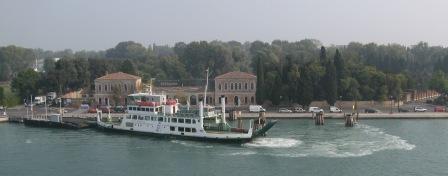

Even natural waves caused by the wind, aided and abetted by the retreating tide, will do some of this work of demolition. But then there are the big public boats — and I’m thinking specifically of waterbuses. They come in several versions here, but the highest number are the vaporettos.
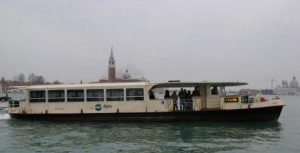
The vaporetto is a specific type of boat, and the public-transport company, which goes by its acronym ACTV, operates 52 of them. Sometimes called “battello,” the vaporetto has a regularly scheduled cousin correctly called a “motoscafo,” though it gets called “vaporetto” too for convenience. It sits lower in the water and carries fewer people, though you might not believe it if you try to get on one at rush hour.
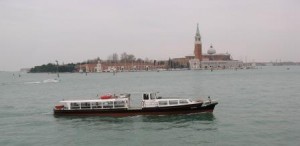
At this moment, the ACTV website informs us that the company operates “about 152” waterborne vehicles. (“About”? You mean you don’t know?) They break it down thus: 52 vaporettos, 55 motoscafos, 10 “single agent motoscafos,” which I can’t interpret for you just now, 16 bigger vaporettos that travel the lagoon (“vaporetti foranei”), 9 motonavi, and 8 ferryboats.
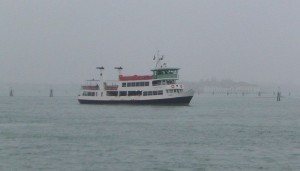
Naturally all of these vehicles cause waves, but what compounds the effect is the undertow they create when they stop at one of the 100 or so bus stops (city and lagoon) to drop and pick up passengers.
It’s pretty simple. Here is an illustration of what happens every time one of these craft comes and goes:

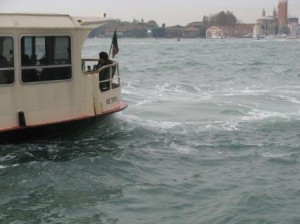

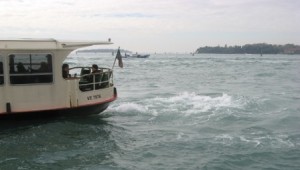

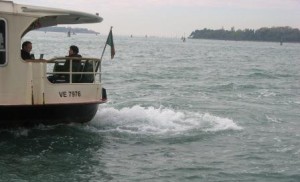
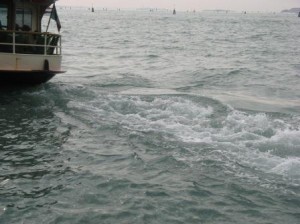
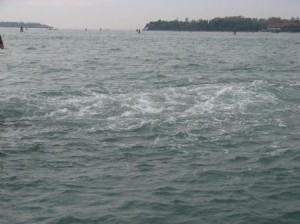
On September 15, 1881, the first vaporetto (“Regina Margherita”) began regular service in the Grand Canal. The imminent arrival of this creation caused tremendous distress and revolt among the gondoliers, who foresaw their doom. Their turmoil is the focus of a marvelous film, “Canal Grande” (1943), starring several then-well-known Venetian actors, such as Cesco Baseggio, plus a number of real gondoliers. Too bad it’s all in Italian.
The first vaporetto was soon followed by a fleet of eight, run by a French company, the “Compagnie des bateaux Omnibus.” Nothing against that noble nation, I merely note that Napoleon Bonaparte, who conquered and devastated Venice in 1797, was also French.
In 1890 the Societa’ Veneta Lagunare began service between Venice and assorted lagoon locations. And so it has gone.
Lino remembers when there were still very few vaporetto stops in the Grand Canal; they were at San Marco, Accademia, San Toma’, Rialto, the railway station, and probably Piazzale Roma, though he won’t swear to it. In what was still a flourishing local culture, the Venetians could find almost everything needed for daily life in their own little neighborhoods.
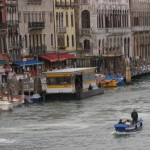
There are now 17 stops on the Grand Canal. They were not installed as something useful to the residents, as noted above, but for the transport of tourists. Shops have begun to close (I don’t lay this fact at the feet of the wave-and-sucking-causing public transport), so as the population has dropped, and the number of tourists has risen, the locals have had to range further afield to find forage, so to speak, and at the same time have had to use public transport which is usually overstuffed with tourists and their luggage. During Carnival, most Venetians do their utmost to stay the hell at home.
The city recognizes that there aren’t enough vaporettos most of the year; during the summer (and Carnival) extra routes and supplementary vehicles are laid on. But eventually some crisis point will be reached where the number of bodies requiring to be moved and the available space in which to do it will collide. To use a term which nobody in the navigation business wants to hear.
Zwingle’s Fifth Law states that “You can get used to anything.” You may quibble, but I can attest that you can definitely get used to this roiling and churning and sucking of many waters. This isn’t good, but neither can you travel all day in a constant state of rage and anguish.
You can give yourself an interlude of relief by going for a little stroll. Ignoring the roaring of motors and the shattering of waves, you can really relax in the city which is extolled for having no cars. I think people who say that must merely mean “no traffic.”
